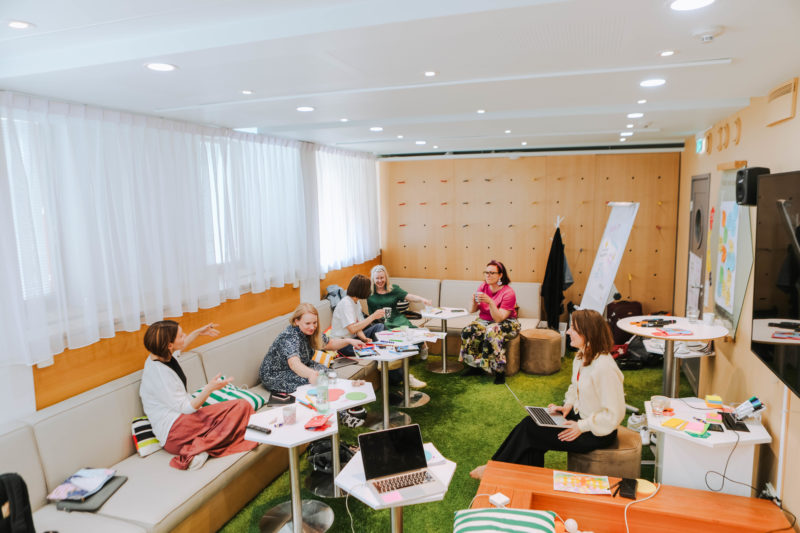Ever heard the joke about the driver who thought everyone else was going the wrong way? It’s a classic example of how we often see others as the problem—just like in meetings. This old Norwegian joke is often told by Thomas Erikson, a behavioural scientist, leadership coach, and author of Surrounded by Idiots.
The DISC model, developed by psychologist W.M. Marston, categorizes personalities into four types—Dominance, Influence, Steadiness, and Consciousness—each represented by a color: Red, Yellow, Green, and Blue. According to Erikson, only 5% of people are purely one color, but our dominant traits shape how we interact and how others perceive us.
And when we step into a meeting room, our personalities come with us. Understanding these dynamics can help us communicate better, reduce friction, and make meetings more effective. Let’s dive in!
1. The Reds want to get things done
Instead of waiting for consensus, the reds want immediate results, as they are solution-oriented and having a ‘time is money’ attitude. They get frustrated when someone else is wasting their time with too much talking or too much looking into details. They are impatient and appear insensitive, as ‘politically correct’ is a term that they don’t believe in.
If there is nothing to gain from the meeting, a red person diverts his attention elsewhere, be it fiddling with their phones and laptops, or they leave the room to answer to ‘that so much more important phone call’. It is the red colleagues who tend to vanish before the meeting is officially closed.
2. The Green- “I hear what you say”
The Greens are great listeners, laid back and supportive. They are just great to have in meetings because of their usually cheerful attitude. Unfortunately, they lack initiative and do not intervene if not asked. A dominantly green person dreads conflict. Being appreciated is very important for them: they want to be everyone’s friend.
You will notice this if the topic of the meeting is about change: the Greens almost become invisible, hoping that it will all go away. Greens would rather linger in the status quo, their way of thinking is ‘why changing if it still works fine?’
3. The Yellow – the one talking too much
The Yellows talk. And talk. And talk.
In some meetings, they take over 50% of the time with their interruptions and comments. They are very articulate, enthusiastic and have great ideas. The downside is, they find it hard to follow through with what they promised, they jump to conclusions and bring a bit too much of their bubbly personality into the room.
4. The Blues – “Yes, but…”
Finally, the Blues: the orderly and disciplined Blues have THE eye for detail. Extremely analytical, they seem to lack the capacity of seeing the ‘big picture,’ focused as they are in not forgetting anything. The Blue personality type needs time to process information, to compartmentalise it somewhere.
Generally, a Blue person is quite pessimistic as well. Listening to them can be extenuating for a yellow or a red personality, who start asking themselves, ‘what’s the point?’ Frustration mounts and in the end, the poor blue is silenced back to the corner, with, most probably, the yellow saying something like ‘Where was I?’.
How does understanding personality types help me?
Once you recognize these personality types, you can use this knowledge to improve your meetings:
- Know your own personality type – Identify your strengths and weaknesses.
- Adapt to others – Adjust your communication style based on who you’re working with.
- Appreciate the differences – Different personalities bring different strengths to the table.
For example:
- Instead of getting frustrated by your Blue colleague’s attention to detail, take a breath and appreciate their precision. Without them, crucial details might go unnoticed. Precision may not be your strength, but it’s theirs—use it to your team’s advantage.
- Help your Yellow colleague stay focused, and embrace their enthusiasm. If they can speak up so easily, why not try it yourself?
- Admire the Reds for their confidence and drive. They are direct, action-oriented, and always pushing forward. Don’t take their bluntness personally—match their pace and they’ll respect the effort.
- Encourage the Greens to share their thoughts and challenge themselves. They may be hesitant to speak up, but their input is valuable. In return, you can learn empathy, patience, and how to build stronger workplace relationships.
Meetings work best when all personality types complement each other. The Yellows bring ideas, the Reds push action, the Greens ensure harmony, and the Blues make sure nothing is overlooked.

Final Thoughts: Embrace the Differences!
Next time you’re in a meeting, take a moment to observe how different personalities interact. Instead of getting frustrated, adapt and work with their strengths. After all, if everyone thought the same way, nothing new would ever happen!
And voilà! The perfect group dynamic!
Read how AI can make meetings more productive





